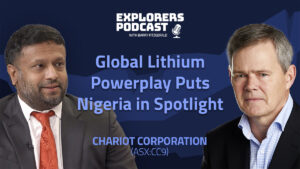MoneyTalks: Tribeca’s Ben Cleary says investors should hold the faith on metals and energy for three key reasons

Pic: Bee32/iStock via Getty Images
MoneyTalks is Stockhead’s regular recap of the ASX stocks, sectors and trends that fund managers and analysts are looking at right now.
Today we hear from Ben Cleary, portfolio manager for the Tribeca Global Natural Resources Fund.
Onshoring, electrification and energy security will continue to be the key themes that lay out an optimistic future for the mining and energy sectors in 2024 despite a tough 2023 for ressies equities.
That’s the take of Ben Cleary, portfolio manager for Tribeca Investment Partners’ Global Natural Resources Fund, who says those three global trends will be “huge demand drivers” for commodities.
“There’s very little debt across the mining, energy and agriculture sectors, strong cash flows, strong capital returns, but if you look at mining share prices they’re kind of flat to down over the last 12 or 18 months,” he told Stockhead.
“There’s obviously pockets that have done well, but generally speaking the sector has been derating on these sort of macro concerns.
“So I think the big bottom up drivers of onshoring, electrification, energy security are going to continue to play out and be very good for the sector and we’re just having to deal with this material volatility in the short term.”
Why renewables are opening the door for nuclear
Around 40% of Tribeca’s natural resources fund is in energy, 50% in metals and 10% in agriculture.
Of that energy component around half is in nuclear, one of the rare growth areas in 2023 with spot uranium prices up around 51%.
With higher interest rates and inflation sending bond yields soaring, finance-reliant renewables developments have been slowing down, slowing the pace of the rollout and opening the door for nuclear and oil and gas.
“Energy I think does look very attractive on a shorter and medium term basis because we’ve had lots of these issues that have been piling up on themselves for some time,” Cleary said.
“Everyone’s putting more and more renewables into the the grid and that’s driving two things.
“First of all, there’s a lot of volatility because obviously the sun doesn’t shine 24 hours a day and the wind doesn’t blow 24 hours a day, so you’re having periods of negative electricity prices, you’re having periods of super high prices of electricity and this is a pretty common issue right around the world.
“What we’ve seen with renewables in the last 12 months is rising bond yields have absolutely smashed the economics of the industry.”
Cleary thinks the biggest beneficiary of that momentum shift is nuclear power.
“Nuclear is one of our highest conviction themes within the portfolio, has been for several years, but we’re still only just getting started on the nuclear trade,” he said.
“Talking to Chinese fuel buyers in recent weeks, they’re talking about consuming 150Mlb a year of uranium by 2040, which is more than total global installed production capacity.
“So we like nuclear, we like gas, we like oil for varying reasons but really they’re all fitting into a broader thematic of energy security, of onshoring.”
Are we near a bottom for battery metals?
Is the battery metals sector ‘mispriced’ over the long term? Cleary thinks so.
“You’ve got these very significant demand-supply deficits for most of the battery commodities, whether it’s copper or nickel, lithium or graphite,” he said.
“On the lithium side this time last year you saw a very big premium in lithium prices, prices went to five times the cost curve.
“So I don’t think it’s been surprising that we’ve seen quite a sharp fall in the lithium price back towards the cost curve. We’ve gone from US$1500/t to US$8000/t back to US$1500/t.
“Now in terms of our analysis of the industry we think quite a few producing companies are actually loss-making at spot on an all-in basis, so I think we’re going to find some sort of base in lithium over the next six to 12 months.”
That’s already happening in graphite. One of the largest producers of natural flake graphite outside China, ASX listed Syrah Resources (ASX:SYR), switched to campaign mining at its Balama graphite mine in Mozambique earlier this year in response to weakening prices for battery anode feedstocks.
But it’s a commodity regarded as a prime candidate for a turnaround after China moved to restrict exports of battery grade graphite products, starting next month.
“We feel like graphite is something that can provide even more torque than lithium over the next 12 months given that we’re already well and truly into the cost curve for that industry,” Cleary said.
“It’s really at the forefront of some of these onshoring type issues given that it’s a commodity that’s so overexposed to Chinese production and the whole value chain of Chinese mine production and conversion”.
Cleary says Tribeca also remains ‘highly convicted’ on copper, where macro economic concerns and a strong US dollar have masked strong demand from rising fixed asset investment in China and emerging supply deficits.
Why can iron ore continue to outperform expectations?
Currently Tribeca has around 60% of its metals portfolio in base and battery metals, but it still has time for precious metals and bulks, which each make up around 40% of its mining holdings.
While lithium prices have proven astonishingly volatile this year, the mainstay of the Australian resources market — iron ore — has shocked analysts with its resilience, currently paying an historically strong US$127/t.
“It’s just one of those commodities consensus always wants to be glass half empty on and we just have not seen the production increases that anyone has forecast consistently over the last decade,” Cleary said.
“Whether it was the companies forecasting, whether it was the sell side, they just haven’t come.
“If we put iron ore into that electrification, energy security, onshoring world where there is issues for lower grade material and the impact that has on carbon emissions these smaller marginal producers will unlikely see the light of day.
“So the market is on a medium term continuing to tighten up because a number of these new projects that were lower grade ores are just not going to get there given the movement to higher grade ores, the whole decarbonisation issues and premiums that are being paid for high grade.”
While the media around China’s heavily indebted property sector has weighed on sentiment, Cleary said there were indicators that in larger Chinese cities the property market was stabilising ahead of a multi-year process to work through those debt concerns.
“It really then becomes a supply side issue and I can’t really see any material supply coming into the market over the next 12 months,” he said.
“We’re still pretty comfortable that you should see average prices of iron ore around US$100/t into triple digits again in 2024.”
Energy stock picks
And which stocks are Cleary’s best bets to play these three key, cross-commodity themes?
When it comes to uranium he likes a couple of big players, Canadian listed Cameco (TSX:CCO), Global Atomic (TSX:GLO) and Energy Fuels (TSX:EFR) are his favourite picks globally.
Cameco is the Western world’s largest uranium producer and close to a pure play on the uranium price. Global Atomic owns the high grade Dasa development in Niger while Energy Fuels, also listed in New York under the code UUUU, is a leading US producer also moving into vanadium and rare earths.
On the ASX he likes Boss Energy (ASX:BOE), which is aiming to restart the Honeymoon uranium project in South Australia early next year.
“Lack of investment in new uranium mines will likely see spot prices go well beyond the top of the cost curve which is US$100/lb vs US$70/lb currently,” Cleary said.
“Nuclear is also a major beneficiary of ‘greenflation’. The economics of wind and solar has been significantly dented by higher yields and higher commodity prices.”
There have been major downgrades from wind developers Siemens and Orsted in recent times.
When it comes to energy he likes Santos (ASX:STO) in oil and gas, with M&A in the US and Asia also going to be big focuses in 2024.
In services, Cleary prefers MMA Offshore (ASX:MRM), where he said “fantastic management has repaired the balance sheet during downturn”.
Cleary think the outlook for MMA suggests strong earnings growth and capital. Meanwhile in thermal coal, he like Glencore globally and Whitehaven Coal (ASX:WHC) on the ASX.
In particular, he likes the recent deal — costing up to $6.4 billion — for Whitehaven to buy BHP’s (ASX:BHP) Daunia and Blackwater met coal mines in Queensland, the subject of a recent bust up between Whitehaven’s management and activist investor Bell Rock Capital.
“Buying from majors has been a very successful strategy and changes mix to 50/50 met/thermal which should increase potential investor base and maximise valuation multiples,” Cleary said.
Metal stock picks
In the metals market, Tribeca likes a lot of the global base metals names, including Freeport, Alcoa, Teck and Glencore, but Cleary’s top ASX copper pick is Bill Beament’s Develop Global (ASX:DVP), which boasts copper and zinc deposits including the Sulphur Springs project and Woodlawn mine, just acquired Essential Metals to take over the Pioneer Dome lithium project and boasts the underground mining services contract on the Bellevue Gold (ASX:BGL) mine.
Cleary says it has copper and lithium leverage, great management and a great business model “funding its own mine development via mining services cash flow generation, very similar to what MinRes has done over the last two decades”. MinRes is a major investor in Develop.
Cleary thinks graphite looks similar to lithium four or five years ago, with prices well down the cost curve — “outlook looks very strong just waiting for downstream to come online,” he said.
Syrah Resources (ASX:SYR) is his top Aussie pick.
He likes its large resource endowment and vertical integration in wait for higher prices.
The lithium sector has come off on much lower pricing, with Pilbara Minerals (ASX:PLS) his top pick on high short interest, large cash balance and its low position on the cost curve, which should see it rebound strongly when pricing recovers, which Cleary sees coming in early 2024.
When it comes to the bulk and diversified miners, Cleary’s top two are South32 (ASX:S32) and Champion Iron (ASX:CIA). Met coal and aluminium exposed S32 is trading on depressed long term commodity multiples, Cleary said, while high grade iron ore producer Champion is his best global exposure to green steel.
Tribeca’s ASX picks

UNLOCK INSIGHTS
Discover the untold stories of emerging ASX stocks.
Daily news and expert analysis, it's free to subscribe.
By proceeding, you confirm you understand that we handle personal information in accordance with our Privacy Policy.








